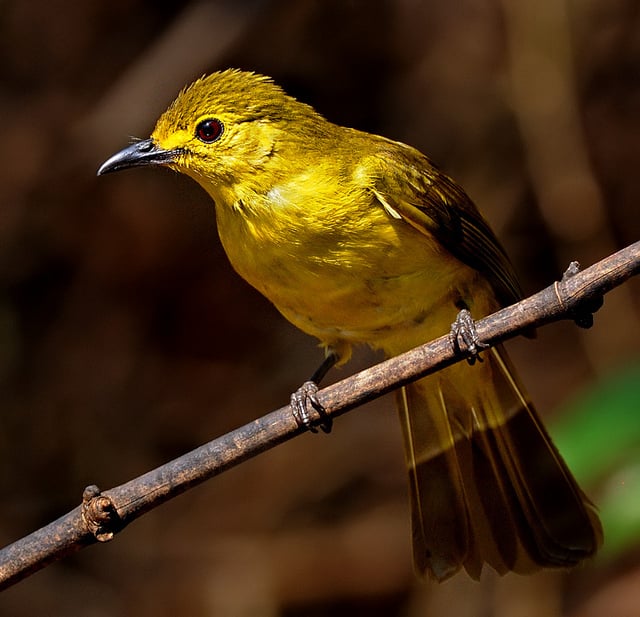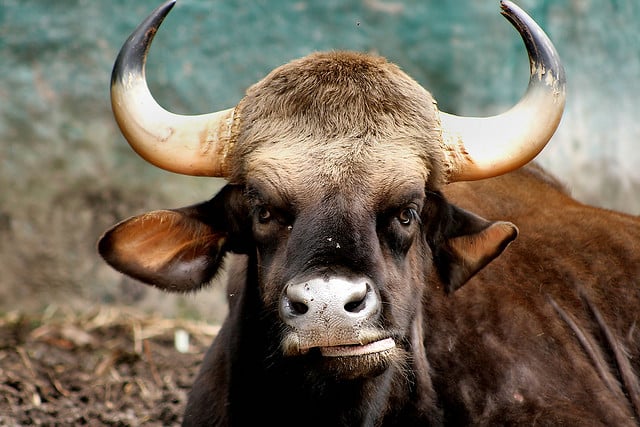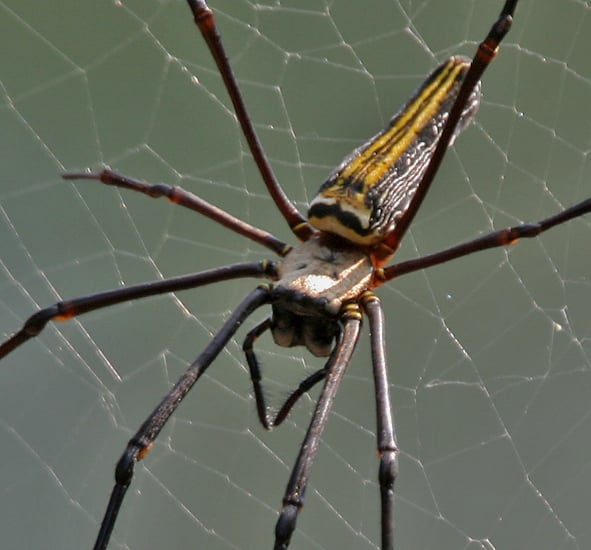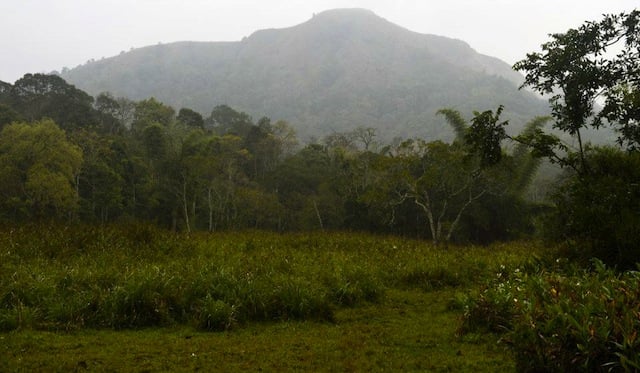Bus-free Through India: That Time I Was Charged By An Elephant

Yellow-Browed Bulbul. Photo courtesy of T-Monk.
Rare Birds
On my Kalypso Adventures India travel itinerary, it called for a leisurely “green walk” through the Periyar Tiger Reserve, a protected area in southern India encompassing 350 square kilometers (140 square miles). And it starts out this way as, with my forest guide Anesh and Kalypso guides Peter and Rattan, I meander carved-out dirt paths, looking at African tulips and rhododendrons. At first, the focus of the walk seems to be birds, as the men frantically pull out their binoculars pointing out Nilgiri Langur, White-Bellied Treepie and Yellow-Browed Bulbul. “Oh, wow! I can’t believe it! It’s a Wynaad Laughingthrush!” shouts Peter, who is visibly shaking with delight as he takes out his recording of bird sounds to interact with the group of apparently very rare birds. While to me the name means nothing, Peter explains he often has clients travel all the way from Europe just to come here and see this very special bird. The Periyar Tiger Reserve is home to over 260 bird species, although my goal is to see large mammals. “What’s the likelihood we’ll see an elephant today?” I ask Rattan, as we’d been searching like crazy to no avail to spot them around Anaerangal Lake, which literally means “Lake where the elephants come down.” Rattan shakes his head. “Not likely.” Because I am was expecting many sightings of interest, I (stupidly) left my GoPro and telephoto lens at Wildernest Bed & Breakfast (Side note: Isn’t this always when the exciting stuff happens?). Although, I did bring my DSLR and 18-55mm kit lens for some general scenery shots.
Gaur. Photo courtesy of phalinn.
The Gaur
I am excited to spot a herd of Gaur, or Indian bison, which look similar to a bull and are not related in any way to the American bison. Prominent features include its large ears, short tail, deeply ridged back and forehead, and enormous horns. These animals are completely wild and are considered vulnerable due to their dwindling population. They’re the tallest species of wild cattle and the largest of extant bovine.
Wood Spider. Photo courtesy of JM Garg.
The Wood Spider
Another finding of interest is the giant Wood Spider, which has a bulbous body with thin streaks of hot yellow. It makes my skin crawl, especially when it starts spazzing out as I get close for a picture. I love it. Just as I think my most exciting finds will be a big spider and non-domestic cow, Anesh stops short in his tracks. An Unlikely Elephant Sighting “Shhhh!!!!” He hisses, holding his hand back, signaling us to stay put. “Elephant.” My heart races. An Indian elephant. In the wild! How lucky am I? Where was my telephoto lens?! (Oh right, back at the hotel). Anesh positions us for a decently clear view of the giant mammal as it munches on lilly plants and reed bamboo. I am able to get an okay photo, although the lush forest — coupled with my miniature 5’2’’ height — obstructs most of my line of sight. While I think our elephant adventure will end there, it is far from over, and soon moves more toward an India horror story. Anesh beckons us to follow him as he weaves like a snake in and out of trails and down steep hills for a closer look. The leaves are slippery from the fresh rain, and at times I find it hard to keep my footing. Finally, we come to the other side of where the elephant is, only to discover it is actually FIVE elephants, three adult females, one baby female and one baby male.Too Close For Comfort
From our position behind a boulder I feel safe, as I try to get a photo of the herd while simultaneously cursing myself for not bringing my zoom lens. We change positions about eight times trying to get a clear view, running up and down the steep hill, scrambling over damp foliage, tripping over branches and getting faces full of spider web. When we finally decide the best place is at the bottom of the hill — near to where the elephants are eating — Anesh grabs my camera and makes his way closer (although still keeps a respectable distance). He beckons for us to follow, as the three of us quietly — or as quietly as possible in a twig-filled forest — tiptoe closer. We turn the camera flash off as to not startle the elephants, and are able to get some beautiful shots even with my crappy lens. The atmosphere seems happy and light. And then it doesn’t. While elephants are generally gentle creatures, they can become very aggressive when they feel their young are threatened. Our first sign mama elephant is getting annoyed is when her ears begin to flap, which is shortly followed by the raising of the trunk and the pointing of its opening in our direction. “She smells us,” whispers Anesh. “Run!!” Without questioning or looking back, I dart full speed, not running in a straight line but to the right, jumping over a stream and running up on a hill. When I glance back, the mama elephant is charging the very spot we had just been standing. We keep running, not stopping until the elephants are out of sight. When we are finally safe I drop to the ground, the mix of exasperation and adrenaline pulling me down like a weight. I turn to Anesh and laugh. “So, how often do you have to run away from a charging elephant?” “Many,” he says flatly. Oh. I’m surprised to hear both Rattan and Peter have also run from elephants “thousands of times.” I wonder if it just comes with the territory of being a guide in India. For some reason I still feel naive about the whole thing. “Do you think the elephant really would have hurt us, or was she just trying to scare us?” I (stupidly) ask. Rattan takes this opportunity to explain to me in graphic detail — complete with charades-like gestures for emphasis — what the elephant would have done to us. “First the elephant wraps its trunk around you. Then it smashes you into the ground three times — ONE, TWO, THREE — before tossing you aside. Then, BAM! [cue ground-shaking stomp], it crushes you.” Okay then. I then learn that within the first week of January 2014 a local was killed in this fashion near Aerangal Lake. In 2013, the number was two. The moral of the story? Don’t f*ck with nature, especially when it has babies. And especially when it weighs five tons. Suddenly, the next day’s 63-mile (102-kilometer) cycling adventure doesn’t seem so daunting.Have you ever had a close encounter with nature?
Stay tuned for more Bus-Free Through India, with new articles in this 8-part series coming out every Tuesday! Featured image courtesy of marfis75 This post is based on a semi-hosted press trip I took with Kalypso Adventures, experiencing their Multi Activity Holiday tour. It’s part of a series called Bus-Free Through India, as the tour focuses on showcasing the real India through cultural, sustainable and adventurous offerings, as well as traveling from place to place by cycling, trekking and kayaking. Stay tuned for this next chapter in my series, Bus-Free Through India.Bonus India Travel Resources
Traveling Northern India: 12 Things To Do Beyond The Temples & Taj Mahal Greatest Goa: Yoga, Dolphins & A Dose Of Clarity On Palolem Beach The Secret To Finding Peace In India Can Be Found In Bundi An Organic Farmstay Experience In Kerala, India 5 Must-Visit Places To Experience The Best Of India A Disappointing Spice Farm Day Trip In Goa (& What To Do Instead) How India Broke Me (& Why I’m Thankful For It) How To Get High (Legally) In Varanasi, India India’s Unique Karni Mata Temple Is Devoted To Worshipping Rats 10 Unforgettable Things To Do In Delhi, India How A Trip To India Taught One Woman The Importance Of Human Connection Ayurvedic Massage In India: Not For The Modest10 Reasons Why You Need To Visit India
5 Amazing Ways You Can Explore India’s Spiritual Side 10 Reasons Why Kerala Should Be Your Next Trip 9 Essential Travel Tips For Southern India India Travel: Houseboating Through Kerala’s Backwaters Cycling The “Scotland Of Asia” To An Organic Farm In India Cycling India’s Cardamom Trail Ascending High Peaks & Hiking Through The World’s Highest Organic Tea Garden In India Why Kerala’s Silent Valley Is One Of The World’s Best National Parks Cycling Kerala’s Culturally-Immersive Canal Route Exploring The Culture Of Northern India Through Food
Hi, I’m Jessie on a journey!
I'm a conscious solo traveler on a mission to take you beyond the guidebook to inspire you to live your best life through travel. Come join me!

Want to live your best life through travel?
Subscribe for FREE access to my library of fun blogging worksheets and learn how to get paid to travel more!




What a crazy experience!
@Ashley: It was!
Awesome story, and very intense! I’d say it was good all 3 didn’t start going on a rampage in unison! Reminded me of the ‘jungle trek’ we took in Chitwan national forest in Nepal… All I can remember is being told what we were ‘supposed to do’ if either a lion charged us (which we saw paw prints on the trail) or if a rhino charged us (which we saw 4 that day)… Good times… It’s what makes travel adventurous though right?!?
@Rory: Absolutely. I did a similar trek in South Africa. Definitely got sweaty palms being told what to do if we were chased by animals that could literally rip us apart, but such a fascinating experience!